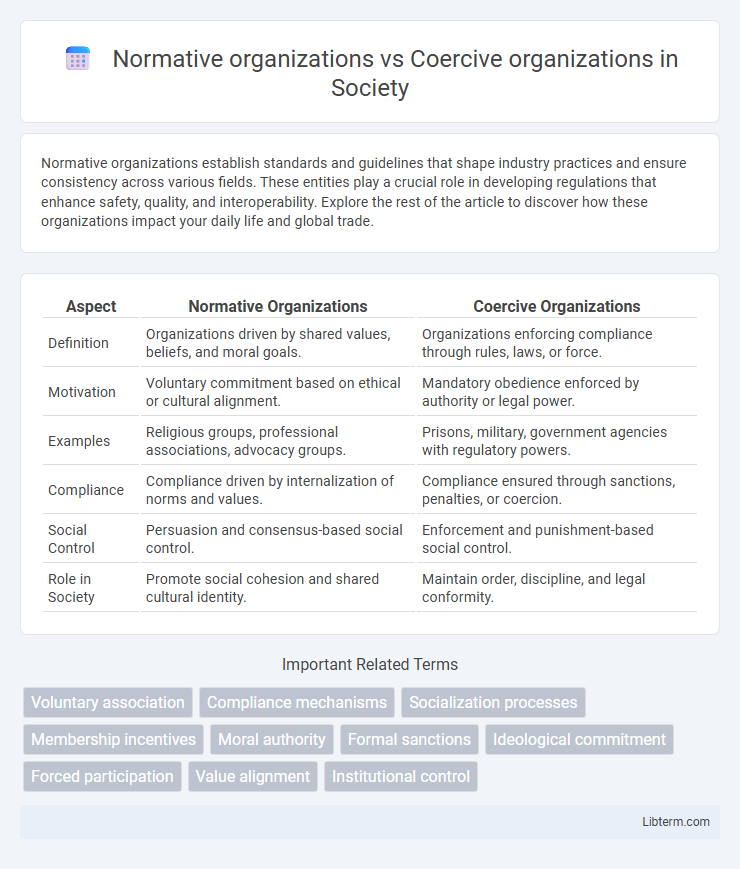Normative organizations establish standards and guidelines that shape industry practices and ensure consistency across various fields. These entities play a crucial role in developing regulations that enhance safety, quality, and interoperability. Explore the rest of the article to discover how these organizations impact your daily life and global trade.
Table of Comparison
| Aspect | Normative Organizations | Coercive Organizations |
|---|---|---|
| Definition | Organizations driven by shared values, beliefs, and moral goals. | Organizations enforcing compliance through rules, laws, or force. |
| Motivation | Voluntary commitment based on ethical or cultural alignment. | Mandatory obedience enforced by authority or legal power. |
| Examples | Religious groups, professional associations, advocacy groups. | Prisons, military, government agencies with regulatory powers. |
| Compliance | Compliance driven by internalization of norms and values. | Compliance ensured through sanctions, penalties, or coercion. |
| Social Control | Persuasion and consensus-based social control. | Enforcement and punishment-based social control. |
| Role in Society | Promote social cohesion and shared cultural identity. | Maintain order, discipline, and legal conformity. |
Introduction to Organizational Types
Normative organizations are institutions driven by shared values and goals, emphasizing voluntary membership and moral commitment, such as religious groups or professional associations. Coercive organizations rely on formal rules and the use of force or sanctions to maintain control, including prison systems and total institutions. Understanding these organizational types clarifies how authority, compliance, and social order function within various social structures.
Defining Normative Organizations
Normative organizations are structured around shared values and norms that motivate membership through intrinsic commitment rather than external pressure. These organizations emphasize collective goals, social beliefs, and a sense of moral obligation to guide behavior and decision-making. Unlike coercive organizations, which rely on force or formal sanctions, normative organizations cultivate voluntary compliance through cultural alignment and identity reinforcement.
Defining Coercive Organizations
Coercive organizations are defined by their reliance on force, authority, or sanctions to control members' behavior, often implementing strict rules and punishments to ensure compliance. These organizations typically operate in environments where conformity is mandatory, such as prisons, military units, or certain bureaucratic institutions. In contrast, normative organizations influence behavior through shared values, norms, and voluntary commitment, fostering cooperation and membership based on common goals.
Key Differences Between Normative and Coercive Organizations
Normative organizations primarily rely on shared values and beliefs to motivate member participation, fostering commitment through a sense of moral obligation or shared goals, whereas coercive organizations use force, threats, or formal rules to ensure compliance and control behavior. The key difference lies in the source of influence: normative organizations exert influence through persuasion and voluntary conformity, while coercive organizations depend on penalties and sanctions to regulate members. This distinction affects organizational culture, member engagement, and operational dynamics significantly.
Membership and Participation Dynamics
Normative organizations rely on membership driven by shared values and voluntary participation, fostering commitment through alignment with collective goals and social norms. Coercive organizations enforce membership and participation through formal rules, sanctions, and obligations, often limiting individual autonomy to ensure compliance. The dynamics of participation in normative organizations are characterized by internal motivation and social integration, while coercive organizations depend on external control and enforcement mechanisms.
Motivation and Control Mechanisms
Normative organizations motivate members through shared values, beliefs, and a common purpose, fostering intrinsic commitment and voluntary participation. Control mechanisms rely on social sanctions, peer pressure, and normative rules that emphasize moral obligation and collective identity. Coercive organizations use formal authority, strict rules, and imposed punishments to ensure compliance, motivating behavior through extrinsic pressure and fear of penalties.
Examples of Normative Organizations
Normative organizations primarily include professional associations, religious groups, and volunteer organizations that promote shared values and social norms without relying on formal authority or enforcement. Examples of normative organizations are the Red Cross, which harnesses volunteer efforts to provide humanitarian aid, and the American Medical Association, which unites physicians to uphold ethical standards in healthcare. These organizations foster commitment through collective goals and identity rather than coercive power or legal mandates.
Examples of Coercive Organizations
Coercive organizations are entities that rely on force, sanctions, or strict regulations to control behavior and ensure compliance, commonly seen in prisons, military institutions, and detention centers. These organizations enforce rules through threats or actual punishment, differentiating them from normative organizations, which motivate members through shared values and goals. Examples include government correctional facilities, mandatory quarantine centers, and certain paramilitary groups.
Social Impacts of Each Organization Type
Normative organizations promote social cohesion and shared values by encouraging voluntary participation based on common beliefs, which fosters community engagement and collective identity. Coercive organizations exert control through formal rules and sanctions, often leading to social order but potentially generating resistance or conflict within affected populations. The social impact of normative organizations tends to enhance social capital and trust, whereas coercive organizations may prioritize compliance and stability at the cost of individual autonomy.
Conclusion: Choosing Between Normative and Coercive Structures
Selecting between normative and coercive organizations hinges on the desired level of member autonomy and motivation; normative organizations thrive on shared values and voluntary commitment, fostering intrinsic motivation, whereas coercive organizations rely on enforced compliance through rules and sanctions, ensuring conformity. Optimal organizational design considers the context, with normative structures suited for environments valuing creativity and collaboration, while coercive structures fit high-control settings requiring strict adherence. Balancing these structures can enhance effectiveness by aligning organizational goals with member behavior and external demands.
Normative organizations Infographic

 libterm.com
libterm.com